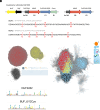A widespread family of ribosomal peptide metallophores involved in bacterial adaptation to metal stress
- PMID: 39602266
- PMCID: PMC11626156
- DOI: 10.1073/pnas.2408304121
A widespread family of ribosomal peptide metallophores involved in bacterial adaptation to metal stress
Erratum in
-
Correction for Leprevost et al., A widespread family of ribosomal peptide metallophores involved in bacterial adaptation to metal stress.Proc Natl Acad Sci U S A. 2025 Sep 23;122(38):e2522214122. doi: 10.1073/pnas.2522214122. Epub 2025 Sep 17. Proc Natl Acad Sci U S A. 2025. PMID: 40961151 Free PMC article. No abstract available.
Abstract
Ribosomally synthesized and posttranslationally modified peptides (RiPPs) are a structurally diverse group of natural products that bacteria employ in their survival strategies. Herein, we characterized the structure, the biosynthetic pathway, and the mode of action of a RiPP family called bufferins. With thousands of homologous biosynthetic gene clusters throughout the bacterial phylogenetic tree, bufferins form by far the largest family of RiPPs modified by multinuclear nonheme iron-dependent oxidases (MNIO, DUF692 family). Using Caulobacter vibrioides bufferins as a model, we showed that the conserved Cys residues of their precursors are transformed into 5-thiooxazoles, further expanding the reaction range of MNIO enzymes. This rare modification is installed in conjunction with a partner protein of the DUF2063 family. Bufferin precursors are rare examples of bacterial RiPPs found to feature an N-terminal Sec signal peptide allowing them to be exported by the ubiquitous Sec pathway. We reveal that bufferins are involved in copper homeostasis, and their metal-binding propensity requires the thiooxazole heterocycles. Bufferins enhance bacterial growth under copper stress by complexing excess metal ions. Our study thus describes a large family of RiPP metallophores and unveils a widespread but overlooked metal homeostasis mechanism in bacteria.
Keywords: metallophore; multinuclear non-heme iron-dependent oxidase (MNIO); ribosomally synthesized and post-translationally modified peptide (RiPP).
Conflict of interest statement
Competing interests statement:The authors declare no competing interest.
Figures





References
MeSH terms
Substances
Grants and funding
LinkOut - more resources
Full Text Sources

